On July 13, Fosun Pharma (Group) announced that it plans to invest US$106 million (approximately RMB 700 million) in the US Butterfly Network. The post-investment valuation is about $1.25 billion (about 8.3 billion).
Who is Butterfly, so that Fosun is so optimistic?
Butterfly is a Delaware ultrasound + artificial intelligence company based in Delaware, USA, established in 2011. Their first ultrasound imaging product, the Butterfly iQ, was approved by the US FDA in September 2017. Through a smartphone application combined with cloud technology, artificial intelligence, deep learning, etc., a single handheld ultrasound probe was successfully completed through multiple inspection modes. The operation of multiple parts of the body, a variety of clinical applications.
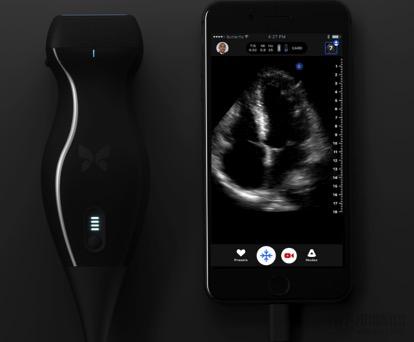
Ultrasound products
Announcement shows that as of December 31, 2017, BNI achieved a main business income of $0 and a net profit of approximately $29.07 million (approximately $194 million).
Taking this opportunity, let's talk about the investment logic of artificial intelligence handheld ultrasound.
Introduction to Pocket Ultrasound
What is the handheld ultrasound, how big is the market, and the domestic blue ocean or the Red Sea?
Pocket ultrasound is a kind of ultrasound equipment like a mobile phone, which can complete the inspections required by the hospital's large B-ultrasound. Since the 1980s, the United States has taken the lead in the development of handheld ultrasound instruments for battlefield rescue. This kind of rechargeable ultrasonic diagnostic instrument with satellite remote transmission image function has played an active role in the US Desert Storm operation. Later, the technology was changed from military to civilian. It was converted into the first medical handheld ultrasonic diagnostic equipment by American GE Company and was first applied to emergency cardiac rapid screening. At present, handheld ultrasound is more popular among American family doctors.
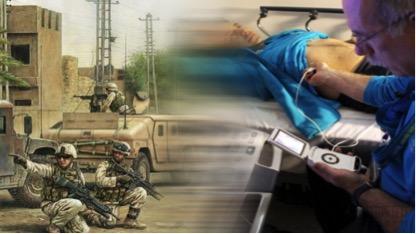
From battlefield rescue to clinical use
Pocket ultrasound is no longer the exclusive equipment of the Department of Ultrasound. A large number of clinicians can easily use it. For pre-examination and initial screening of some diseases (such as thyroid screening), patients no longer need to go to the ultrasound department to queue up. The examination can be completed; the doctors at the grassroots level can also carry the on-the-spot ultrasound to carry out on-site inspections, so that the grassroots people can enjoy the ultrasound examination service without going out of the village.
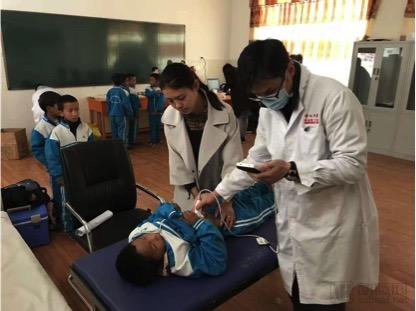
Palm ultrasound for primary screening
In field medical or disaster relief, casualties are often unable to obtain accurate medical diagnosis in the first time, which leads to delays in treatment. Pocket ultrasound is easy to carry, and has low dependence on power supply. It can effectively solve disaster relief caused by lack of medical diagnostic equipment. The rescue problem.
GE's first generation of handheld ultrasound, VSCAN 1.0, was launched in the United States in 2008, causing a sensation. It was named "50 Best in 2009" by Time magazine and the well-known science magazine "New Age of Technology". Inventions and "100 Best Scientific and Technological Achievements in 2010".
Unfortunately, GE's handheld ultrasound equipment is not selling well. The most obvious reason may be that a manufacturer of large-scale medical imaging equipment sells a small device that sells very cheaply. For its internal sales staff, of course, the profit from selling large equipment is more. Finally, you know, GE The handheld ultrasound has become a product line Supplement of such a multinational corporation, and will never become its flagship product. No matter how high the industry praises it, no matter how big the real demand of the market is, it is difficult to reverse.
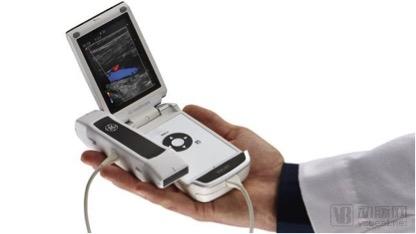
GE's VSCAN
So how big is the handheld ultrasound market, and is the market education completed?
First of all, in China, Pocket Ultrasound is a new blue ocean market. Doctors need education. Although GE's VSCAN was listed 10 years ago, GE did not spend a lot of energy on market education, so this is not an import substitution market. It is a blue ocean market to be developed.
But the good news is that this market is not as ridiculous as we assumed! Earlier, the Ministry of Science and Technology had listed portable handheld ultrasound as a key research and development project in the 13th Five-Year Plan.
In August 2016, China's first handheld ultrasound (Langsheng Technology Production) was officially put into medical use.
Since 2017, two companies have been certified and entered the marketing stage. Pocket ultrasound has also emerged in major professional forums and exhibitions.
In November 2017, the “Domestic Portable Pocket Ultrasound Promotion Application Symposiumâ€, sponsored by the China Medical Equipment Association and sponsored by the Ultrasound Equipment Technology Branch of the China Medical Equipment Association, fully affirmed the importance of the domestic portable handheld ultrasound in the specialty and grassroots promotion applications. necessity.
Including some primary care and remote mountain aid projects, Pocket Ultrasound has successfully joined the government procurement list with its portability advantages.
This blue ocean market includes the clinical departments of 20,000 first-, second-, and third-level hospitals in China, 70,000 township health centers and community service centers, 640,000 village health centers, and huge overseas markets. It can be said that it is very tempting. Forced.
Industry overview
First of all, in the development of the industry of handheld ultrasound, it is worth mentioning that domestic progress and overseas are flat.
The world's major handheld ultrasound products and companies see the following list:
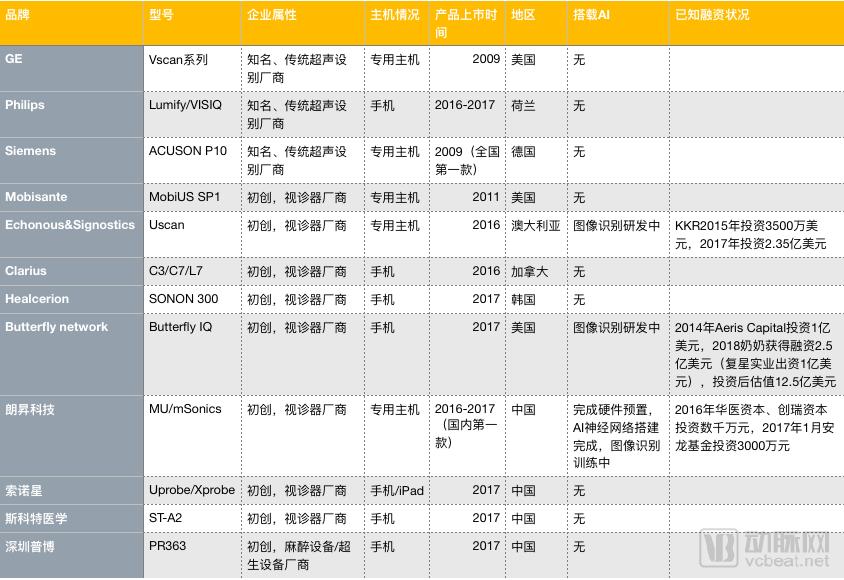
From a global perspective, handheld ultrasound equipment has experienced two wave of products.
The first wave: the giants headed by GPS start off first. In 2009-2011, the products included GE's Vscan generation machine, Siemens' Acuson P10 and Mobisante's MobiUS. Due to the design concept and technical level, there are many defects in ease of use and image quality.
The second wave: start-ups at home and abroad start at the same time. In 2016-2017, Chinese companies and foreign companies are basically in sync. They are the first handheld ultrasound products in the past two years. The country is the first to be promoted, and Sonostar and Suzhou Scott are closely followed. There are Signostics in Australia, Clarius in Canada, and American Butterfly in Fosun. The new generation of products has been greatly improved in terms of design concepts and technical means compared to the first generation, and the ease of use and image quality have been significantly improved. Basically eliminate the first wave of products.
It can be seen that the vast majority of handheld ultrasound manufacturers in the world are mainly start-ups. There are several licenses in China, and the start-up time is not slow. From the perspective of artificial intelligence development, three companies around the world set up special teams to carry out ultrasound labor. Intelligent research, Australian Signostics, American Butterfly, and China's Langsheng, and such artificial intelligence assisted demand biased to delineate organ structure and delineate lesions.
Next, we will give a brief introduction to the three handheld ultrasound + artificial intelligence companies.
1. Echonous & Signositcs
Signositcs was acquired by ultrasound equipment company Echonous, raising $35 million in 2015, $235 million in 2017, and investing in PE giant KKR. Uscan has a deep learning algorithm based AI bladder delineation, volume calculation and peripheral vein guidance.
EchoNous – Signostics' R&D team consists of innovators from different fields such as healthcare, artificial intelligence, industrial design, manufacturing and software engineering, with proven ultrasound AI R&D capabilities. The founder and technical team of Signostics is very powerful. There is no public information on hardware technology and platform. The data source access channel is also unknown. However, the application scenarios are only bladder sketching and volume calculation and blood vessel guidance. The data source requirements are not high, but the data is not high. Lack of source can cause the product to fall into the bottleneck in subsequent application development.
2, Butterfly Network
Butterfly is a US handheld ultrasound company. The main ultrasound product is an ultrasound probe plus a Butterfly IQ that can connect to transmit data to the iPhone chip. In 2014, it raised US$100 million and invested in Aeris Capital. In July 2018, it raised US$250 million, of which Fuxing Industrial invested US$100 million.
Its Butterfly IQ equipment uses the company's own ultrasonic chip technology to integrate the performance of these three typical ultrasonic probes into a 2D matrix array of thousands of MEMS. Currently used for imaging musculoskeletal, cardiac and peripheral blood vessels, and then dedicated to advanced areas such as AI recognition and tumor screening. At present, AI relies on cloud computing in terms of computing power, and it is not clear that there are plans to improve the hardware platform and transmission speed in the future. The AI ​​data source is currently not disclosed. The price of a single accessory product is $2,000 (excluding tariffs).
3. Langsheng Technology
Langsheng Technology is a high-tech company engaged in the research and development and production of miniature ultrasonic imaging equipment and high-end intelligent hardware products. At present, it is mainly used for handheld ultrasound and portable ultrasound, as well as intelligent identification of medical ultrasound applications through artificial intelligence recognition of ultrasound images.
The founder team is excellent, imaging experts + intelligent technology experts.
In the field of artificial intelligence, Langsheng specializes in the development of intelligent ultrasound specialized products for clinical application scenarios, including: instruction interaction and control applications based on AI speech recognition, carotid plaque recognition for carotid artery screening, and pain and anesthesia Brachial plexus recognition in application, AI image enhancement technology for ultrasound imaging, etc.
Application scenario
Unlike traditional large-scale ultrasound, handheld ultrasound is not used by ultrasound doctors, but primarily for clinicians.
Pocket ultrasound has opened up three large-scale ultrasound-inaccessible incremental markets: 1. Hospital clinical department, emergency/emergency market. 2. Primary medical institution market. 3. Out-of-hospital disaster emergency market.
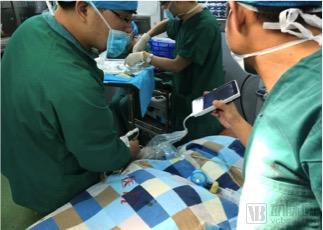
Anesthesiologist using handheld ultrasound
It is worth mentioning that Pocket Ultrasound is a major help in primary care and medical assistance in remote areas.
Traveling to remote mountainous areas, the terrain is complex, rainy and muddy, when the car can't reach, the doctors can only walk on the equipment, portable handheld ultrasound is particularly useful; especially when the mountain power is cut off, only the palm that does not need external power supply Ultrasound equipment also works.
Speaking of a medical aid collection story, the 2017 National Community Medical Service Volunteer Group went to Tibet Nyingchi to carry out a week-long medical assistance activity. The road was far away. The highest altitude on the way reached more than 4,700 meters, and the working environment was nearly 3,000 meters above sea level. The ultrasound group of the Volunteer Group went to the village of Bomi County to conduct health checkups and echinococcosis screening for the villagers. At that time, the volunteer group took the handheld ultrasound equipment.
Science, liver hydatidosis is a terrible parasitic disease. Also known as hepatic hydatid disease. In China, it is mainly popular in Xinjiang, Qinghai, Ningxia, Gansu, Inner Mongolia and Tibet provinces where animal husbandry is developed. In layman's terms, such parasites "eat" the human liver, and such diseases are generally diagnosed by ultrasound.
This time, in Tibet, in the comprehensive examination of the abdomen beyond the scope of the medical examination, the volunteer group conducted a disease screening for 2246 Tibetan compatriots, and found 4 cases of hepatic hydatid disease, 7 cases suspected, 1 case of kidney cancer and 1 case of bladder cancer. Diffuse liver damage, renal hamartoma, horseshoe kidney, kidney deficiency, kidney stones, 1 case, 50 cases of gallstones, 3 cases of hydronephrosis, and diagnosed hepatic hemangioma, acute cholecystitis and other diseases, It provides a sufficient basis for controlling the progress of the disease and further prevention.
After the story is over, there is still a lot of role in primary ultrasound for handheld medical care. In order to allow more grassroots doctors to use handheld ultrasound extensively, the function of artificial intelligence has to be mentioned.
Sketch AI+ Pocket Ultrasound
Because the biggest resistance and pain point of ultrasound screening for primary medical care is that it does not understand and does not use ultrasound. Artificial intelligence-assisted rapid identification and delineation of ultrasonic dynamic parts will be the most effective and convenient solution to the above pain points.
We divide the current artificial intelligence in the field of ultrasound into diagnostic AI and delineation of AI.
1. Provides AI for the sketching function (CFDA Class 2).
2. Provide AI for assisted diagnosis including benign and malignant discrimination functions (CFDA three categories, the current approval policy is unclear, and the state is actively building the database).
The first kind of AI is enough to help Pocket Ultrasound to rapidly develop the application of clinical departments in secondary and tertiary hospitals, especially the ultrasound screening of primary medical care, because the biggest resistance and pain point of primary screening for ultrasound screening is that it does not understand and will not With ultrasound, there is no doubt that artificial intelligence-assisted rapid identification and delineation of ultrasonic dynamic parts will be the most effective and convenient solution to the above pain points, and the current approval channel is smooth and has no resistance. This application is very grounded. Of course, this also requires a large number of clinically positive medical records to train machine learning and optimize neural networks.
The second type of AI is currently very hot and is also a future trend, but at present there is still no small resistance from technology to approval. This application can help handheld ultrasound to really detonate the grassroots market in the future, and it is also worth looking forward to, but it requires patience.
According to insiders, clinicians are very welcome for this kind of delineation of AI handheld ultrasound. When used as a visual inspection device, it can make the doctor's diagnosis process more intuitive, and also reduce the need to transfer patients to ultrasound department for ultrasound examination. Trouble. And different forms of ultrasound instruments can play a different role for different application scenarios.
When applied to clinical departments, the portability of ultrasound is very high, so handheld ultrasound is more needed by clinicians, which is more convenient to use, cheaper, and the clarity and functions can meet their requirements. . It is also widely used in other application scenarios. Similar to the emergency center, the portable sketching function AI ultrasound can greatly increase their work efficiency and facilitate the visit; it is also very popular for the education of new doctors, helping them to identify organs, tissues and The lesions can make them better to get started, make faster progress, and save the trouble of professional doctors teaching.
At the same time, for the grassroots medical staff (mainly township doctors, village doctors, nurses and other medical personnel, who have not received ultrasound diagnostic training, even those who do not fully understand the anatomical knowledge), with the AI, the same Can be used quickly.
Pocket ultrasound technology barrier
In general, the number of physical channels is not as high as possible. The higher the power consumption, the larger the volume. The algorithm chip is the soul, which is the key to miniaturization of devices. It can break through hardware limitations and reach higher images. Quality; post-processing ability, screen quality is a soft modification plus sub-item; long-term use should pay attention to system stability, poor stability will trigger a medical accident.
The imaging quality of ultrasound equipment is closely related to two aspects: one is the number of physical channels on the hardware, and the other is the level of algorithm chip implementation.
1 , the number of physical channels
The number of physical channels can be regarded as the displacement of the automobile for the ultrasonic device. The more the number of channels, the more electrical signals are transmitted at one time, and the more array elements are activated at one time on the probe end, the more the sound waves are emitted. The richer, the more echoes the echoes obtained and the subsequent conversion, the more diverse the imaging. In the number of physical channels of medical ultrasound equipment, various manufacturers continue to try, the number of channels of the current high-end large color ultrasound has reached 128 or even higher, and the number of channels of the medium-end large color ultrasound has reached 64, the number of 32 channels is low. The large-scale color ultrasound still exists in the market, but it is gradually being phased out. The increase in the number of physical channels can undoubtedly directly increase the image quality, but it will inevitably bring changes, the required equipment is large, the data transmission line will be thick, and the power consumption will increase. This has little effect on large-scale ultrasound equipment, but it is a fatal drawback for miniaturized ultrasound equipment, so that before the launch of the first domestic handheld ultrasonic instrument in China, the Chinese ultrasound industry still does not believe in handheld ultrasound with medical value. The achievability of the device.
For large-scale ultrasound, the domestic replacement wave is being staged vigorously in the middle and low-end large-scale ultrasound market. This is inseparable from the continuous development and maturity of China's ultrasonic industry atmosphere. The gap between China's ultrasonic manufacturers and hardware manufacturers is rapidly shrinking. However, in the high-end equipment market, there is still a big gap between Chinese brands and international brands, and this gap is largely reflected in the implementation level of algorithm chips.
2, algorithm chip
If the number of physical channels is compared to the body of ultrasonic performance, algorithm chip implementation can be understood as the soul of ultrasound performance. The hardware provides the basic resources for the implementation of ultrasound imaging, but how to effectively allocate and utilize resources to maximize is the scope of the algorithm chip technology. Excellent ultrasound core algorithms and chip implementations allow ultrasound equipment to perform at performance levels well beyond existing hardware levels. For example, when the number of physical channels is 8 channels, the imaging effect of 32 channels is virtualized. This requires a precise and ingenious design concept for signal transmission and resource allocation, and requires a systematic and long-term technical accumulation. At present, many well-known domestic ultrasonic brands are completely comparable to imported brands at the hardware level, but there is still a big gap between the research and development of algorithm chip technology and imported brands. The algorithm implementation of ultrasound equipment does not have a unified standard in the industry, and its uniqueness is extremely high, so this can often open the performance gap between products.
3, post processing and screen
In addition to the above two points, post processing power and screen quality can also have a very large impact on image quality. The first two points are similar to the hard indicators and are the basis of imaging. The last two points are similar to soft modifications. Post-processing technology, good post-processing can play an excellent "beauty" effect, transforming the original low-quality image into a face, giving the viewer a clear and delicate experience while ensuring high image reproduction, which is a highly skilled process. Means put high demands on the experience of the technical team.
Second is the quality of the screen. An advanced screen and a normal screen can also make a significant difference to the same output signal. Because a major attribute of handheld ultrasound is portable, the use environment is quite different from large ultrasound. The light source is not fixed, and the light conditions are normal, so a screen that can be clearly imaged under various lighting conditions is undoubtedly the gain of the image quality of the product. For example, Langsheng Technology has configured AMOLED all-weather screen. This display has high contrast and extremely fast response speed. At present, it is mainly used by some large mobile phone manufacturers, such as Samsung high-end models and Iphone X; most importantly, AMOLED The screen can be clearly displayed around the clock, independent of light, so it is especially important in outdoor and emergency scenes.
4, stability
In addition to imaging quality, system stability of medical ultrasound equipment is also particularly important. As a simple example, if a picture lag or downtime occurs during the ultrasound guided puncture, it is likely to directly cause a medical accident. Even if the application scenario of the ultrasound device is not intraoperative, due to the special real-time requirements of medical ultrasound examination, the picture delay and the Karton will bring a very poor operating experience, and greatly affect the doctor's work efficiency. The system stability of ultrasonic equipment should be satisfied by mature system implementation technology. The system implementation is not as high as the uniqueness of the algorithm chip. There are certain established standards in the industry. Ordinary enterprises can also implement basic system operation according to established rules, but There are obvious bottlenecks. Conversely, if you want to achieve better power consumption levels and system stability than the industry, the requirements for the company's system implementation experience will be very high.
Artificial intelligence technical barriers: high computing power + low power consumption + real-time
1, high computing power + low power consumption
In terms of computing power, although the AI ​​needs only a few hundred neural networks, it is usually carried on a large device. When deploying the neural network on a handheld device, it will encounter insufficient GPU power, low power consumption and Hardware costs and other challenges.
In order to achieve real-time ultrasound imaging diagnosis and treatment, it is very important to have a good mobile hardware platform and software and hardware development team.
For example, Langsheng Technology's products reserve GPU/DSP for AI in the device. With the low-power Qualcomm 820 hardware platform, the AI ​​operation in the mobile terminal is realized through a large number of neural network optimization and system adaptation. It can optimize up to thousands of neural networks and deploy them on the hardware system of mobile terminals. Basically, the AI ​​is applied to handheld devices.
The AI ​​chips commonly used by other manufacturers, such as Nvidia chips, are very expensive and consume a lot of power. It is unrealistic to implement AI operations in mobile terminals.
2, real-time: another feature of handheld ultrasound AI
That is to say, the user is working on the side to get the result. If the AI ​​operation is put into the cloud according to the current conventional scheme, and the AI ​​is driven by the upload-operate-download process, the real-time dynamic effect of the ultrasonic detection is inevitably limited, which is a fatal blow to the user experience.
This also requires that the AI ​​operation be dropped from the cloud to the local, which is not a small requirement for hardware performance. Therefore, regardless of the future image quality improvement or AI operation requirements, the dedicated handheld host is a general trend.
Blood Pressure medication,Blood pressure medication,N-Acetyl-L-carnosine Online,Dacarbazine Solubility,Dacarbazine and Temozolomide,
Human APIs - Blood Pressure raw , APIs Raw powder , Antipyretic And Analgesic , Antibiotic & Antibacterial
Blood pressure medication,Blood pressure medication,N-Acetyl-L-carnosine Online,Dacarbazine Solubility,Dacarbazine and Temozolomide
Xi'an Henrikang Biotech Co.,Ltd , https://www.henruikangbio.com